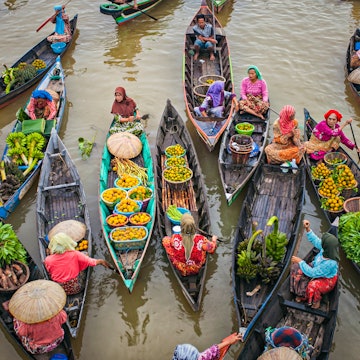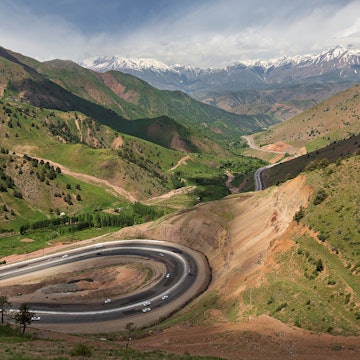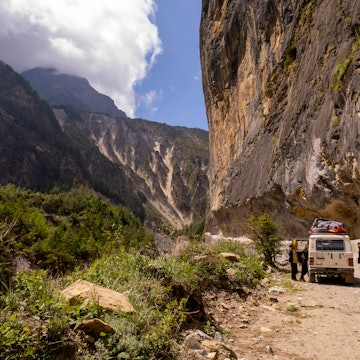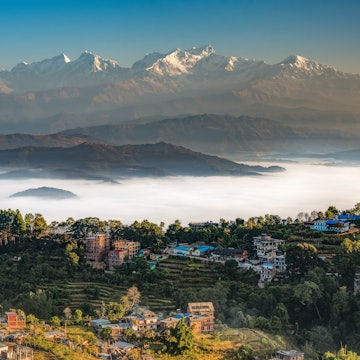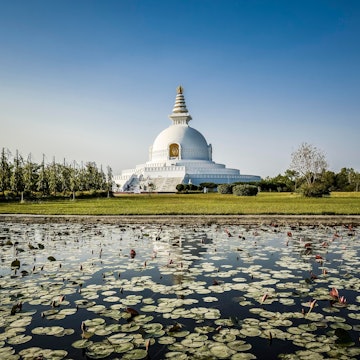

Your first trip to India is certain to open your eyes to a whole host of new experiences. chris piason / Shutterstock
You never forget the first curry you eat with your hands; the momentary awkwardness, the sticky feel of sauce between your fingers, and, of course, the taste – somehow all the sweeter for your show of dexterity. But India is full of first experiences, each more unexpected, unfamiliar and wonderful than the last, which add together to make one of the most surprising, challenging and rewarding travel destinations on the planet.
Discovering India is not something that happens all at once, on a single trip. This is a country the size of a continent, and understanding India’s customs and quirks is a lifelong quest. Nevertheless, it’s those first experiences – your first train ride, your first banana-leaf thali, your first temple blessing – that will stay with you for a lifetime.
Here’s our pick of the best ‘firsts’ you can look forward to ahead of a trip to India, all of which mark the transition from merely visiting to becoming, subconsciously, part of the subcontinent.

Your first meal on a banana leaf
Plates and cutlery are so last year. In the Indian south, meals are dished out on a freshly wiped banana leaf, and eaten with the fingers, without the aid of a spoon, fork or knife. Learning the Indian way of eating is a skill that every traveller to India should acquire; indeed, when you leave the tourist trail, cutlery is a rare novelty. But once you get over the initial squeamishness about getting hands-on with your food, you’ll soon be wolfing down curries like a local.
The trick to eating rice and runny sauces with your fingers is to clump the rice and sauce into balls, sliding them off a ramp created with your fingers into your mouth. Remember to do this one handed – in India, the left hard is reserved for personal ablutions. Only eat with your right hand, and carry a bottle of anti-bacterial gel to avoid skin-carried bugs.
The best banana leaf thalis are served in steamy South Indian cities such as Mysuru (Mysore), Madurai, Chennai and Bengaluru. Alongside bottomless servings of rice and roti (chapatis), your banana leaf will be topped with assorted curries – usually vegetarian, though some places offer a choice of veg and non-veg dishes – and sides such as curd, dhal (stewed lentils), pickles and even desserts. It’s a South Indian feast, with no environmentally-unfriendly washing up to worry about at the end.

Your first temple blessing
Faith is far from a private matter in India. Blessings, invocations and rituals all take place in full public view – at temples, shrines, along the banks of sacred rivers, in homes, and even out in the street – and visitors are routinely invited, nay railroaded, into proceedings. Your first blessing at a Hindu temple can feel a bit like a drive-by baptism, but it’s an indelible part of the Indian experience.
Most likely, you’ll first be offered a blessing when entering a temple courtyard, or wandering along sacred ghats (ritual steps), by a white-robed priest wearing a sacred Brahmin thread. You may be whisked to the inner sanctum, and invited to sprinkle blessed water or waft sacred fire, with a whirlwind explanation of the temple deities and their wish-granting powers.
Almost every temple blessing finishes with a chanted prayer and a daub of colourful kunkum powder on the forehead, representing the third eye and devotion to a specific sect of Hinduism (though you don’t need to hold Hindu beliefs to participate in this distinctively Indian ritual). You’ll also be asked to make a donation – locals invariably do, so you’re not being singled out – and offered prasaad, ritual food blessed by the gods.

Your first train booking
Train rides anywhere have a little sprinkling of magic, but in India, the fairy dust is heaped on in spades. From the moment you set foot on the platform, you’ll be plunged headlong into the irresistible intensity of the country. Hawkers hawk, porters push, waiting passengers eat tiffin-pot meals or snooze under shawl blankets, and chai-wallahs (tea sellers) fill the platforms with a high-speed, song-like chant of "ek chai, ek chai, ek chai".
Just the act of booking your first train ticket will fill you with elation at having mastered one of the most fascinating, furious examples of bureaucracy on the planet. To book your train, you need to know the train number, the abbreviations for the exact train stations, the seat classes, and which of the dozens of ticket windows to queue at. You also need at least a working understanding of the system of wait-listing and quotas in case your chosen train is booked solid.
It’s possible (if complicated) to book online, and somewhat easier if you visit the special foreign quota desk at major stations such as Mumbai’s CST and New Delhi railway station (the International Tourist Bureau is located upstairs), but the sense of accomplishment that comes from booking your first ticket in the chaotic surroundings of the general ticket hall will linger long after the train has dropped you at your destination. This is one of the great gauntlets to run before you can say you have truly arrived in India. For more tips, check our guide to booking trains in India.
Once you’ve secured your ticket, prepare yourself for the next wonderful India first – rattling through the countryside with a cup of chai in hand.
Your first Indian shave
For male travellers, going for a shave in India is a step back to the golden age of male grooming. Entering an Indian barber’s shop is the first step in a flamboyant piece of public theatre, that begins with the almost ritualistic snapping of a fresh razor blade and ends with a vigorous head massage.
Part of the fun of a traditional shave with a cutthroat razor is surrendering to the process. A shave is an act of grooming; an art performed by the skilled person on the other end of the blade, and should be allowed to unfold in its own time. Having committed to the process, you put yourself entirely in the hands of the person delicately sliding a sword-sharp blade just millimetres from your jugular; mental images of Sweeney Todd add a definite frisson to proceedings.
To start, you’ll be lathered with foamy soap, applied with a hog’s hair brush, before your skin is pulled taut in every possible direction to ensure that not a single hair escapes the whispering blade. With the undergrowth cleared, you’ll be rubbed with potassium alum, a natural astringent that tightens the skin and sterilises any microscopic nicks and scratches, before a pampering rub with moisturiser and aftershave.
The coup de grâce is the head massage to finish, a vigorous pummelling and drumming of the fingers that ends with sudden, unexpected twists of the neck and slaps on the forehead with hands grasped together, as if in prayer. It might sound a little like being the loser in a pehlwani (Indian wrestling) match, but actually the process is thoroughly invigorating.

Your first visit to a gurdwara
The Sikh religion has a legendary reputation for hospitality, and a visit to a gurdwara (literally, the ‘door to the guru’) is a humbling reminder of the common humanity that binds people together, regardless of colour or creed. Topped by ribbed, lotus-like domes, gurdwaras reverberate to the hypnotic chanting of passages from the Guru Granth Sahib, the Sikh holy book, and ceremonial weapons are prominently displayed inside, a reminder that Sikhism is a martial order, as well as a singularly welcoming philosophy.
Nowhere is this welcome more apparent than when visiting a langar, the communal gurdwara kitchen and dining hall, where free meals are provided to all comers (a donation is appropriate).
At major shrines such as the Golden Temple in Amritsar, the experience is like being a spontaneous guest at a vast Indian banquet. And we mean vast – the Golden Temple’s Guru-ka-Langar feeds a staggering 100,000 pilgrims per day. Meals are simple but nourishing – chapatis, curries and rice – eaten cross-legged on the floor, surrounded by people from every walk of life. It’s a testament to India’s remarkable power to bring people together.
You might also like:
Top tips for your first time in India
Where to get off the beaten track in India
Why northeast India is the place to travel right now










